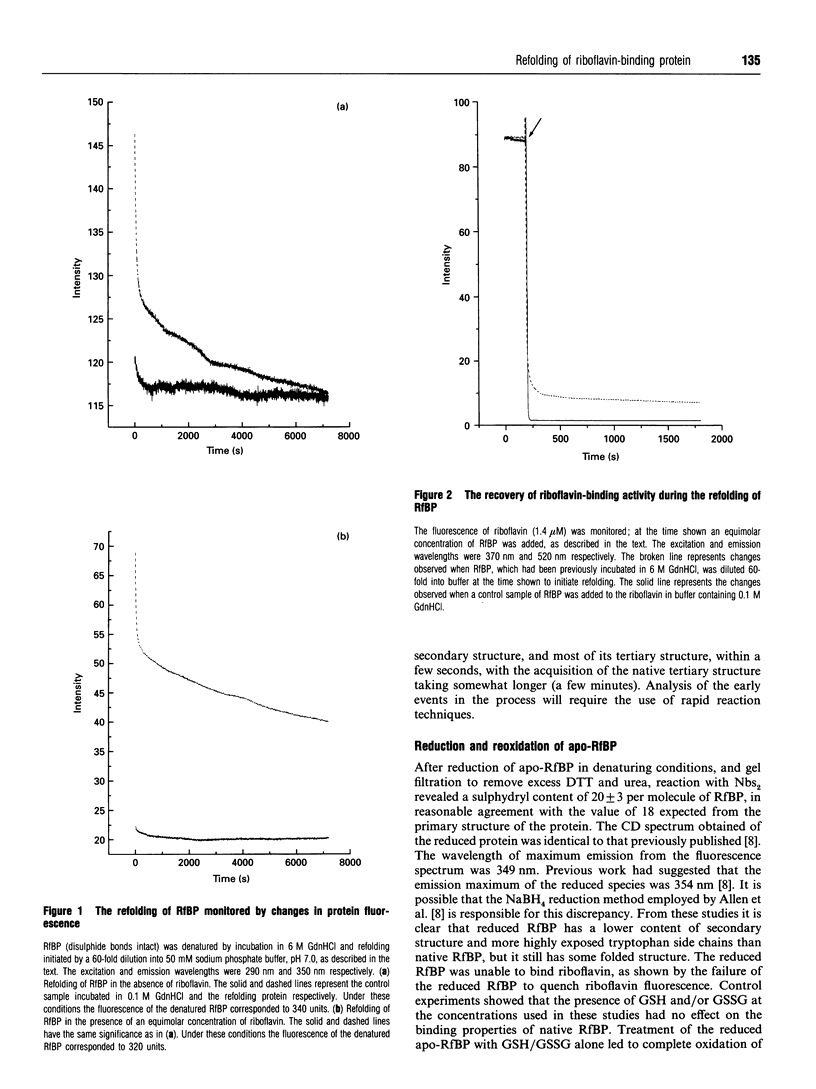Abstract
Hen egg white riboflavin-binding protein (RfBP) contains nine disulphide bonds. Provided these remain intact, the refolding of RfBP after incubation in 6 M guanidinium chloride is highly efficient with at least 95% of the binding activity regained within 3 min. Kinetic studies indicate that this regain consists of at least two phases. When the disulphide bonds of RfBP are reduced, reoxidation using a mixture of oxidized and reduced glutathione leads to less than 5% recovery of activity. However, if protein disulphide isomerase (PDI; EC 5.3.4.1) is present during the reoxidation nearly 50% activity can be regained, suggesting that PDI may play an important role in the maturation of RfBP in vivo.
Full text
PDF




Selected References
These references are in PubMed. This may not be the complete list of references from this article.
- Allen S., Stevens L., Duncan D., Kelly S. M., Price N. C. Unfolding and refolding of hen egg-white riboflavin binding protein. Int J Biol Macromol. 1992 Dec;14(6):333–337. doi: 10.1016/s0141-8130(05)80074-1. [DOI] [PubMed] [Google Scholar]
- Bergman L. W., Kuehl W. M. Formation of an intrachain disulfide bond on nascent immunoglobulin light chains. J Biol Chem. 1979 Sep 25;254(18):8869–8876. [PubMed] [Google Scholar]
- Creighton T. E. Protein folding pathways determined using disulphide bonds. Bioessays. 1992 Mar;14(3):195–199. doi: 10.1002/bies.950140310. [DOI] [PubMed] [Google Scholar]
- Darby N. J., Creighton T. E. Catalytic mechanism of DsbA and its comparison with that of protein disulfide isomerase. Biochemistry. 1995 Mar 21;34(11):3576–3587. doi: 10.1021/bi00011a012. [DOI] [PubMed] [Google Scholar]
- Dobson C. M., Evans P. A., Radford S. E. Understanding how proteins fold: the lysozyme story so far. Trends Biochem Sci. 1994 Jan;19(1):31–37. doi: 10.1016/0968-0004(94)90171-6. [DOI] [PubMed] [Google Scholar]
- ELLMAN G. L. Tissue sulfhydryl groups. Arch Biochem Biophys. 1959 May;82(1):70–77. doi: 10.1016/0003-9861(59)90090-6. [DOI] [PubMed] [Google Scholar]
- Farrell H. M., Jr, Mallette M. F., Buss E. G., Clagett C. O. The nature of the biochemical lesion in avian renal riboflavinuria. 3. The isolation and characterization of the riboflavin-binding protein from egg albumen. Biochim Biophys Acta. 1969 Dec 23;194(2):433–442. doi: 10.1016/0005-2795(69)90103-2. [DOI] [PubMed] [Google Scholar]
- Freedman R. B., Hawkins H. C., McLaughlin S. H. Protein disulfide-isomerase. Methods Enzymol. 1995;251:397–406. doi: 10.1016/0076-6879(95)51143-1. [DOI] [PubMed] [Google Scholar]
- Freedman R. B., Hirst T. R., Tuite M. F. Protein disulphide isomerase: building bridges in protein folding. Trends Biochem Sci. 1994 Aug;19(8):331–336. doi: 10.1016/0968-0004(94)90072-8. [DOI] [PubMed] [Google Scholar]
- Freedman R. B. Protein folding. Folding helpers and unhelpful folders. Curr Biol. 1994 Oct 1;4(10):933–935. doi: 10.1016/s0960-9822(00)00210-4. [DOI] [PubMed] [Google Scholar]
- Freedman R. B. The formation of protein disulphide bonds. Curr Opin Struct Biol. 1995 Feb;5(1):85–91. doi: 10.1016/0959-440x(95)80013-q. [DOI] [PubMed] [Google Scholar]
- Hamazume Y., Mega T., Ikenaka T. Characterization of hen egg white- and yolk-riboflavin binding proteins and amino acid sequence of egg white-riboflavin binding protein. J Biochem. 1984 Jun;95(6):1633–1644. doi: 10.1093/oxfordjournals.jbchem.a134776. [DOI] [PubMed] [Google Scholar]
- Hamazume Y., Mega T., Ikenaka T. Positions of disulfide bonds in riboflavin-binding protein of hen egg white. J Biochem. 1987 Jan;101(1):217–223. doi: 10.1093/oxfordjournals.jbchem.a121894. [DOI] [PubMed] [Google Scholar]
- Kozik A. Disulfide bonds in egg-white riboflavin-binding protein. Chemical reduction studies. Eur J Biochem. 1982 Jan;121(2):395–400. doi: 10.1111/j.1432-1033.1982.tb05800.x. [DOI] [PubMed] [Google Scholar]
- Lang K., Schmid F. X., Fischer G. Catalysis of protein folding by prolyl isomerase. Nature. 1987 Sep 17;329(6136):268–270. doi: 10.1038/329268a0. [DOI] [PubMed] [Google Scholar]
- Lilie H., McLaughlin S., Freedman R., Buchner J. Influence of protein disulfide isomerase (PDI) on antibody folding in vitro. J Biol Chem. 1994 May 13;269(19):14290–14296. [PubMed] [Google Scholar]
- Mega T., Hamazume Y., Hong Y. M., Ikenaka T., Nong Y. M. Studies on the methods for the determination of phosphorylation sites in highly phosphorylated peptides or proteins: phosphorylation sites of hen egg white riboflavin binding protein. J Biochem. 1986 Nov;100(5):1109–1116. doi: 10.1093/oxfordjournals.jbchem.a121814. [DOI] [PubMed] [Google Scholar]
- Mücke M., Schmid F. X. Intact disulfide bonds decelerate the folding of ribonuclease T1. J Mol Biol. 1994 Jun 24;239(5):713–725. doi: 10.1006/jmbi.1994.1408. [DOI] [PubMed] [Google Scholar]
- Peters T., Jr, Davidson L. K. The biosynthesis of rat serum albumin. In vivo studies on the formation of the disulfide bonds. J Biol Chem. 1982 Aug 10;257(15):8847–8853. [PubMed] [Google Scholar]
- Puig A., Gilbert H. F. Protein disulfide isomerase exhibits chaperone and anti-chaperone activity in the oxidative refolding of lysozyme. J Biol Chem. 1994 Mar 11;269(10):7764–7771. [PubMed] [Google Scholar]
- Rupp K., Birnbach U., Lundström J., Van P. N., Söling H. D. Effects of CaBP2, the rat analog of ERp72, and of CaBP1 on the refolding of denatured reduced proteins. Comparison with protein disulfide isomerase. J Biol Chem. 1994 Jan 28;269(4):2501–2507. [PubMed] [Google Scholar]
- Walker M., Stevens L., Duncan D., Price N. C., Kelly S. M. A comparative study of the structure of egg-white riboflavin binding protein from the domestic fowl and Japanese quail. Comp Biochem Physiol B. 1991;100(1):77–81. doi: 10.1016/0305-0491(91)90088-u. [DOI] [PubMed] [Google Scholar]
- Wang C. C., Tsou C. L. Protein disulfide isomerase is both an enzyme and a chaperone. FASEB J. 1993 Dec;7(15):1515–1517. doi: 10.1096/fasebj.7.15.7903263. [DOI] [PubMed] [Google Scholar]
- White H. B., 3rd, Merrill A. H., Jr Riboflavin-binding proteins. Annu Rev Nutr. 1988;8:279–299. doi: 10.1146/annurev.nu.08.070188.001431. [DOI] [PubMed] [Google Scholar]
- Zanette D., Monaco H. L., Zanotti G., Spadon P. Crystallization of hen eggwhite riboflavin-binding protein. J Mol Biol. 1984 Dec 25;180(4):1185–1187. doi: 10.1016/0022-2836(84)90278-x. [DOI] [PubMed] [Google Scholar]
- Zheng D. B., Lim H. M., Pène J. J., White H. B., 3rd Chicken riboflavin-binding protein. cDNA sequence and homology with milk folate-binding protein. J Biol Chem. 1988 Aug 15;263(23):11126–11129. [PubMed] [Google Scholar]


